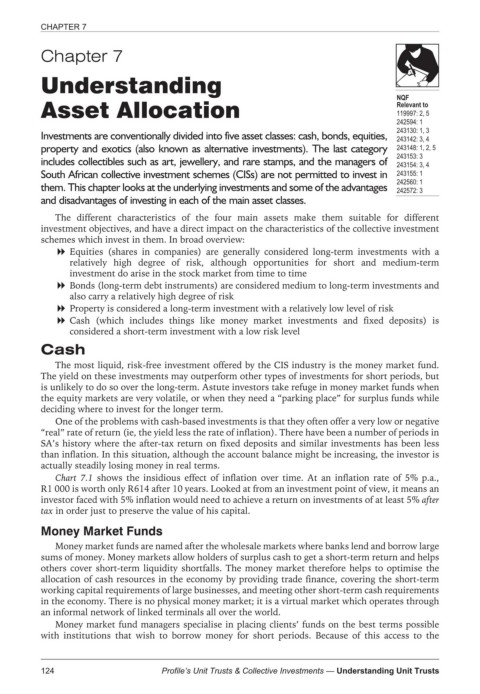Page 126 - Profile's Unit Trusts and Collective Investments 2021 issue 2
P. 126
CHAPTER 7
Chapter 7
Understanding Asset Allocation
Understanding
NQF
Asset Allocation Relevant to
119997: 2, 5
242594: 1
243130: 1, 3
Investments are conventionally divided into five asset classes: cash, bonds, equities, 243142: 3, 4
property and exotics (also known as alternative investments). The last category 243148: 1, 2, 5
243153: 3
includes collectibles such as art, jewellery, and rare stamps, and the managers of 243154: 3, 4
South African collective investment schemes (CISs) are not permitted to invest in 243155: 1
242560: 1
them. This chapter looks at the underlying investments and some of the advantages 242572: 3
and disadvantages of investing in each of the main asset classes.
The different characteristics of the four main assets make them suitable for different
investment objectives, and have a direct impact on the characteristics of the collective investment
schemes which invest in them. In broad overview:
Equities (shares in companies) are generally considered long-term investments with a
relatively high degree of risk, although opportunities for short and medium-term
investment do arise in the stock market from time to time
Bonds (long-term debt instruments) are considered medium to long-term investments and
also carry a relatively high degree of risk
Property is considered a long-term investment with a relatively low level of risk
Cash (which includes things like money market investments and fixed deposits) is
considered a short-term investment with a low risk level
Cash
The most liquid, risk-free investment offered by the CIS industry is the money market fund.
The yield on these investments may outperform other types of investments for short periods, but
is unlikely to do so over the long-term. Astute investors take refuge in money market funds when
the equity markets are very volatile, or when they need a “parking place” for surplus funds while
deciding where to invest for the longer term.
One of the problems with cash-based investments is that they often offer a very low or negative
“real” rate of return (ie, the yield less the rate of inflation). There have been a number of periods in
SA’s history where the after-tax return on fixed deposits and similar investments has been less
than inflation. In this situation, although the account balance might be increasing, the investor is
actually steadily losing money in real terms.
Chart 7.1 shows the insidious effect of inflation over time. At an inflation rate of 5% p.a.,
R1 000 is worth only R614 after 10 years. Looked at from an investment point of view, it means an
investor faced with 5% inflation would need to achieve a return on investments of at least 5% after
tax in order just to preserve the value of his capital.
Money Market Funds
Money market funds are named after the wholesale markets where banks lend and borrow large
sums of money. Money markets allow holders of surplus cash to get a short-term return and helps
others cover short-term liquidity shortfalls. The money market therefore helps to optimise the
allocation of cash resources in the economy by providing trade finance, covering the short-term
working capital requirements of large businesses, and meeting other short-term cash requirements
in the economy. There is no physical money market; it is a virtual market which operates through
an informal network of linked terminals all over the world.
Money market fund managers specialise in placing clients’ funds on the best terms possible
with institutions that wish to borrow money for short periods. Because of this access to the
124 Profile’s Unit Trusts & Collective Investments — Understanding Unit Trusts

